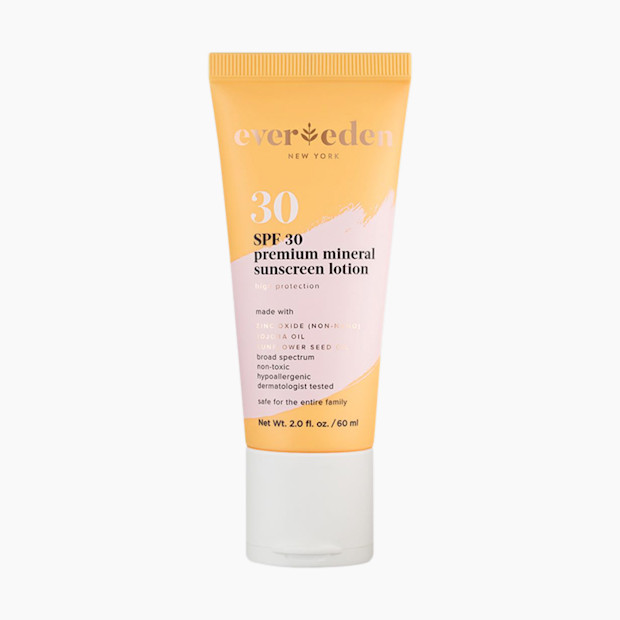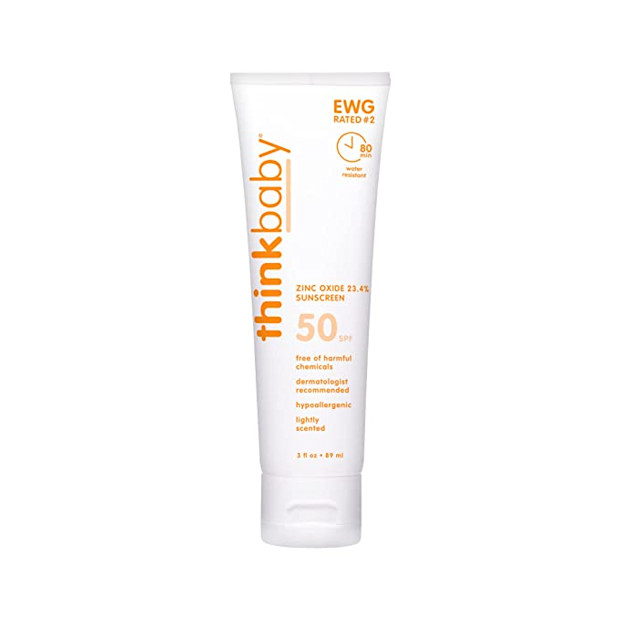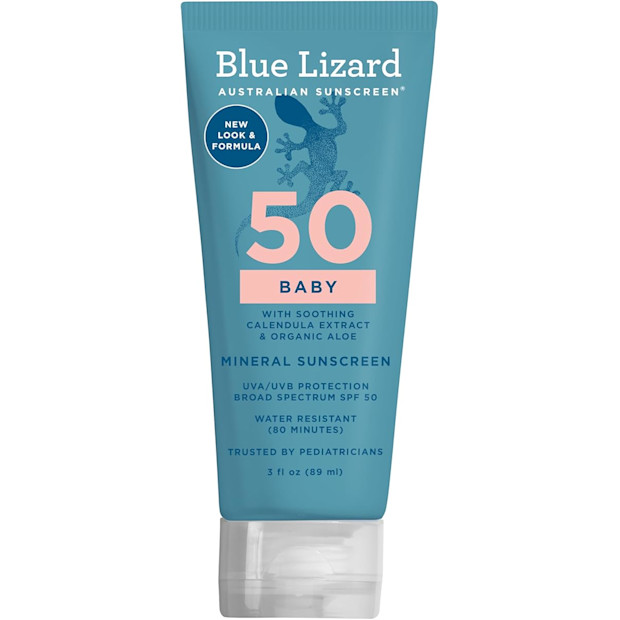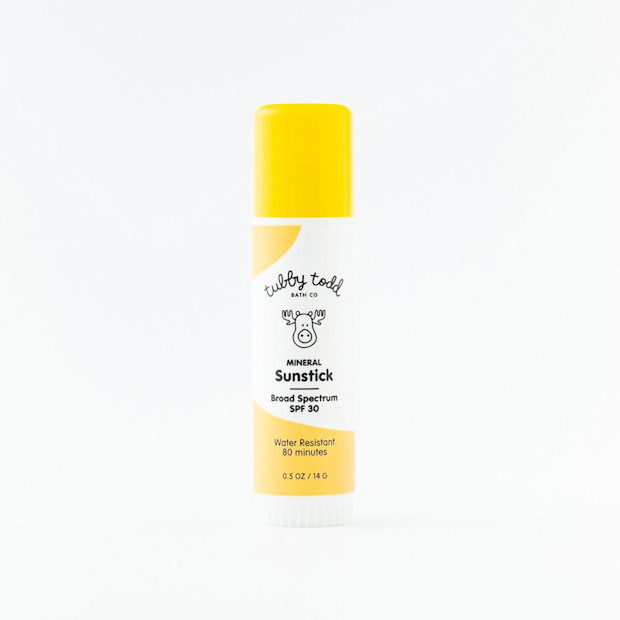
The Best Sunscreens to Keep Your Baby Protected All Summer Long
Baby-friendly sun protection is a must-have for outdoor fun.

In This Article
Splashing at a water table, taking a stroll around the neighborhood or running (crawling) wild and free in the grass—no matter how your baby spends their time in the sun, it's really important to keep their delicate skin shielded from UV rays. But babies’ skin is sensitive to certain sun-blocking chemicals, so pediatricians recommend only using mineral-based sunscreen with high SPF and other baby-friendly features.
Our pick for best overall baby sunscreen, Thinkbaby SPF 50+ Mineral Sunscreen, offers high-SPF, broad-spectrum protection, is free from fragrances and harsh chemicals and is even reef-friendly. Parents love its non-greasy texture, minimal white cast and 80-minute water resistance, making it a great choice for all-day outdoor adventures even if baby gets in the water.
While lots of parents (and babies) like our top pick, it may not be the perfect sunscreen for every baby—so we have a handful of other options to help you find the one. (And a pro tip: sunscreen is one of a few baby products that are HSA/FSA eligible!) Here are all of our top picks for the best baby-friendly sunscreens, plus how to make sure you're choosing the safest sun protection so you and baby can maximize your fun in the sun.
- Best for Darker Skin
 Evereden Premium Mineral Sunscreen SPF30 - Natural Cucumber, 60mlFrom $25.00
Evereden Premium Mineral Sunscreen SPF30 - Natural Cucumber, 60mlFrom $25.00
Why Trust Babylist?
Babylist is the expert in baby; we know baby gear inside and out. We talk with parents face-to-face in our showroom and on our user panels and hear from thousands annually via our Best Baby Products online survey. We know what items millions of expecting parents are adding to their baby registries.
Firsthand professional and personal experience. As a Babylist editor and parent of two, I’ve spent 8+ years researching and testing baby products—including lots of different sunscreens. Through both professional expertise and personal experience, I understand what sunscreen features work best for sun-loving babies, especially those with extra-sensitive skin.
Expert POV. When choosing the best sunscreens for your baby, there are lots of things to consider, like ingredients, SPF level and formulation (lotion vs spray vs others). For expert advice on these features, I consulted Dr. Christina Johns, a pediatrician & pediatric emergency physician at PM Pediatric Care, and Dr. Adena Rosenblatt, a pediatric dermatologist at UChicago Med.
Sunscreen data. At Babylist, we regularly analyze the products our users are adding to their registries (and the products that they aren’t). Utilizing this data helps us narrow down the best sunscreens we should add to this guide.
Parent feedback and reviews. I also took into account hundreds of product reviews from parents, so you can rest assured the sunscreens on this list are loved by both parents and the babies who wear them.
How We Judged the Best Baby Sunscreens
The Best Overall Baby Sunscreen
Pros
- Doesn't feel greasy
- Water resistant for up to 80 minutes
Cons
- Slight white cast
- Has a slight scent
A lot of mineral sunscreens can feel a little heavy and greasy, but not Thinkbaby’s formula. But just because it feels light doesn’t mean it’s skimpy on sun protection—it’s got SFP 50+, so it's considered very high protection, and it's packed with 20% zinc oxide and offers up to 80 minutes of water resistance. Like most mineral sunscreens, this one leaves a slight white cast, but if you make the effort to really rub it in well, you can minimize the whiteness more than most other mineral sunscreens.
Some parents said they didn’t care for the slight smell that accompanies this sunscreen. While it doesn’t have any added fragrances, it does have a mild, distinct scent that might be off-putting to some.
Honorable Mention
Pipette Mineral Sunscreen Lotion Broad Spectrum - Spf 50
From $16.19Pros
- Minimal white cast
- Water resistant for up to 80 minutes
Cons
- May feel slightly greasy and/or sticky
- Need to shake the bottle before applying
The Pipette brand has been a growing favorite among parents for the past few years, and their mineral sunscreen is no exception. It’s got all the features that make a sunscreen a safe choice for babies: it’s lightweight yet full-coverage, free from harsh chemicals with no added fragrance, leaves a minimal white cast (though some product reviews did mention that it leaves a bit of a shimmer behind) and offers up to 80 minutes of water resistance.
Pipette gets our Honorable Mention spot (rather than Best Overall) because the consistency and feel can fall a little short. Some product reviews said that Pipette can sometimes feel greasy or sticky before it’s fully absorbed. It also requires a good shake before applying to ensure the formula is properly mixed, otherwise it can be runny.
Most Foolproof Sunscreen
Pros
- Color-changing cap
- Water resistant up to 80 minutes
- Reef-friendly
Cons
- Squeeze tubes can leak
It's easy to understand the risk of sun damage when in direct sunlight, but what if it's overcast? To help you know when sunscreen is necessary for your little one, Blue Lizard tubes feature a special cap that changes from clear to bright purple when exposed to harmful UV rays, even if it's cloudy outside! The color-changing UV cap is a major hit among parents, and as one reviewer said, “it’s a good reminder to throw more [sunscreen] on your kiddo.”
Along with the UV detection technology, it’s also water-resistant, has a minimal white cast, goes on smooth with a non-greasy feel and is even reef-friendly (so you don’t have to worry about your baby’s dip in the ocean being harmful to marine life). Several parents mentioned in their product reviews that it rubs in really easily—even on wiggly, sunscreen-hating toddlers.
As great as this sunscreen is, parents tend to complain about the packaging. From personal experience, this is my one-and-only, go-to sunscreen, and I’ve always had issues with the squeeze tube leaking either out of the cap or from the top seam. Sealing it in a plastic zip bag is a quick fix, but still a pretty annoying flaw if you’re always taking it on the go.
Best Sunscreen for Darker Skin
Evereden Premium Mineral Sunscreen SPF30 - Natural Cucumber, 60ml
From $25.00Pros
- No white cast
- Moisturizing
Cons
- Pricey
- Has a mild fragrance
If your little one is rockin' lots of melanin, you're probably all too familiar with the white residue that mineral formulas can leave behind. That's because mineral sunscreens are typically made with zinc oxide, which is normally white. But here's a sunscreen that's made with clear zinc oxide, meaning it goes on clear and stays clear, no matter how dark your baby’s skin is.
It also features jojoba and safflower oil, so it provides all-day moisture for dry skin. It’s good for sensitive skin, too—as one parent said in their product review, “My family has extremely sensitive skin, and this is one of the few that doesn't irritate skin.” Parents love that it’s lightweight, easy to spread and good for all skin types.
While Evereden is certainly the most sheer mineral sunscreen on our list, it’s also the priciest at about twice the cost of the other lotions. It also features a fresh cucumber scent, which may be irritating to extra sensitive skin. So if you’re looking to pay closer to drugstore prices or have something completely fragrance-free, then our other picks might be better options.
Best Sunscreen Stick
Pros
- Great for faces and ears
- Smooth, creamy application
Cons
- Not meant for full-body coverage
- Pricey
While lotion sunscreens are best for fully covering baby's skin, sometimes a stick sunscreen can come in handy, especially if your baby is extra wiggly. Swipe it over tops of tiny ears or across baby’s face for a quick and easy application—no rubbing in necessary. Most sunscreen sticks are notoriously solid and a little hard, requiring a little extra pressure to get them to spread, but Tubby Todd’s version is creamy, and parents say it glides on super smooth and is “so easy to apply sunscreen on my wriggly little one.”
The main downside of stick sunscreens is that, while it’s great for the face, it’s not meant for full-body coverage, so you’ll still need to use a lotion-based sunscreen for everywhere else. And the Tubby Todd Sunstick in particular is a little pricey compared to others on the market, but we think the glide-on formula is worth the extra few dollars.
Do Babies Need Sunscreen?
Yes, but only babies six months and older, and only on skin that isn’t covered by clothing or a hat. The FDA and American Academy of Pediatrics don’t recommend putting sunscreen on babies younger than six months old. For babies six months to one year old, try to use as little sunscreen as possible, says Dr. Adena Rosenblatt, a pediatric dermatologist at UChicago Med. Instead, do your best to keep them out of direct sun and stick to the shade.
If shade isn't available, clothing is a preferred option over slathering sunscreen all over your baby. "I recommend using clothing as the primary method of sun protection," Dr. Rosenblatt says, "with coverage for arms and legs, a hat and sunglasses if you can keep them on." If baby is going to be in the water, there are plenty of baby swimsuits with long sleeves to keep little arms covered. And for all those parts that aren't covered—face, neck, hands—then it's fine to put a little bit of sunscreen on (sunscreen sticks are great for that).
The other reason for full-coverage clothing: "You should reapply sunscreen every two hours when you're outside," says Dr. Rosenblatt. "With active children, it's a lot easier to just have that clothing coverage than to have to continuously worry about reapplying sunscreen."
The above guidance also applies to kiddos older than one year—and you, too!—but once they're around that age, it's okay to apply sunscreen to more of their skin. Since a sunburn can happen in as little as 10 minutes—depending on how fair your skin is and the time of day (UV rays are at their most intense from 10 a.m. to 2 p.m.)—you’ll want to have a baby-friendly sunscreen handy. And remember, it takes time for sunscreen to do its magic, so be sure to apply it 30 minutes before sun exposure.
Another thing to keep in mind: using proper sun protection on your baby and building that habit now will help them in the long run. "I think the most important part for parents to understand is that the majority of sun damage occurs within the first 18 years of life, so what you do early on to protect their skin from the sun is really going to have lifelong effects down the road," Dr. Rosenblatt says.
Do babies need specific “baby” sunscreen?
By now, you’ve got it down that babies should only use mineral sunscreen—but what about all those mineral sunscreens out there that don’t say “baby” on them? “Parents don’t need to worry about exclusively buying ‘for babies’ specific sunscreen,” says Dr. Christina Johns, a pediatrician and pediatric emergency physician at PM Pediatric Care. “More important than the designation of ‘for babies,’ it’s better to focus on the actual ingredients.” She says that parents should look for products with zinc oxide and titanium dioxide, and avoid extra fragrances and other potential irritants.
Dr. Johns adds that “baby sunscreens” don’t necessarily have different ingredients than regular mineral sunscreen; there are plenty of unscented, non-irritating mineral sunscreens out there that are marketed toward adults rather than babies.
When choosing a sunscreen to use on your child, look for these five key components:
Broad-spectrum coverage. Since UVB rays cause sunburns and UVA rays can prematurely age skin and cause melanoma, choose a broad-spectrum sunscreen to protect from both types of rays.
Mineral/physical blockers. Chemicals like oxybenzone and octisalate are often used in non-mineral sunscreens and work by sinking into the skin and then absorbing and deferring UV rays. Those chemicals can irritate sensitive skin, so it’s best to go with natural blockers like zinc oxide and titanium dioxide, which are hypoallergenic. These minerals sit on top of the skin and reflect away both UVA and UVB rays (a.k.a. broad-spectrum coverage). While it's fine to use chemical sunscreens on older kids and adults with healthy skin (i.e. skin that's not sensitive or prone to eczema or rashes), dermatologists recommend only using mineral sunscreens on babies and toddlers.
Water resistant. Sunscreens labeled "water resistant" will stand up to sweat and water for either 40 or 80 minutes (check the label to see what the specific formula provides). You'll need to reapply sunscreen after this time period.
At least SPF 30. This is the minimum SPF number that's recommended for babies and toddlers. SPF 50 is the most common in baby sunscreen—anything higher than that only provides marginally more protection.
Non-aerosol. Sunblocks come in sticks, sprays and lotions, but pediatricians recommend using lotions over any other type. "You have to keep in mind that the lotions and creams are going to have much better coverage than the sticks or the sprays," Dr. Rosenblatt says. Sticks are great for small, targeted areas, especially on baby's face, but they're not practical for full-body coverage and should be used alongside a lotion. Additionally, Dr. Johns adds that “while sunscreen sprays seem easier to apply, it’s difficult to guarantee a uniform application on the skin which could result in sunburn, and if inhaled can be a lung irritant.”
So while lotions may take more time to apply, they’re worth it to make sure your baby is fully covered. Be sure to rub it in well, and make sure all the exposed parts are covered—don't forget tops of feet, backs of knees, ears and neck too. And apply it about an inch or so underneath the hem shirts and shorts, in case they ride up during play.
A quick note about bug sprays: If you're putting both sunscreen and bug spray/insect repellant on your little one, be sure to apply the sunscreen first and allow it to get mostly dry before applying the insect repellant on top. To make sure baby's skin is protected to the max, check out our recommendations for the best baby-friendly bug sprays.
Sunscreen Glossary
Sunscreen bottles tend to have quite a bit of jargon on them, so let's define some key terms you're likely to see.
Broad Spectrum
Sunscreen that protects against both UVA and UVB rays.
Mineral Sunscreen
A type of sunscreen that uses minerals (active ingredients are typically zinc oxide and/or titanium dioxide, also known as physical blockers) to repel UV rays, as opposed to chemical blockers that absorb UV rays (and also absorb into your skin—mineral sunscreens don't absorb into your skin, but sit on top). Think of mineral/physical blockers as wearing mirrors over your skin, whereas chemical blockers are more like covering yourself in sponges.
Non-Allergenic/Hypoallergenic
These sunscreens don't have chemicals like oxybenzone, benzophenones, cinnamates and dibenzoylmethanes, which can cause a rash in people with sensitive skin. They often don’t have added fragrances, either.
Reef-Friendly/Reef-Safe
Sunscreens specially formulated to not be hazardous to marine environments, and an important consideration if you’re visiting a beach, ocean, sea or anywhere marine life lives. Ingredients that are not friendly to coral reefs include oxybenzone, octinoxate, octocrylene, 4-methylbenzylidene camphor, PABA, parabens, triclosan, nanoparticles or “nano-sized” zinc or titanium and any form of microplastic, such as exfoliating beads or glitter. For reef-friendly ingredients, look for sunscreens that explicitly say “non-nano.”
SPF
Sun Protection Factor, the measurement of how well a sunscreen protects against UVB rays (low protection: SPF 6-14; medium protection: SPF 15-29; high protection: SPF 30-49; very high protection: SPF 50+).
Titanium Dioxide
A naturally occurring oxide of titanium used in mineral sunscreens because of its ability to reflect and scatter UV rays away from the skin.
UVA
Longer ultraviolet rays that can cause skin aging (especially wrinkles) and skin cancer.
UVB
Shorter ultraviolet rays that provide Vitamin D but can also cause skin burning and skin cancer.
Waterproof
Sorry, but there's no such thing as actual waterproof sunscreen. All sunscreen washes off or loses its SPF in water after up to 80 minutes.
Water Resistant
Sunscreen that retains its SPF after being submerged in water (or sweat) for up to 80 minutes (the closest you'll find to "waterproof" sunscreen).
Zinc Oxide
A powdery mineral that sits on top of the skin and reflects and scatters UV rays. It also soothes irritated skin, and you can often find it in diaper rash creams, makeup, foot powders and burn medications.
Is sunscreen HSA/FSA-eligible?
Yes! If you have a Health Savings Account (HSA) or a Flexible Savings Account (FSA) through your employer or health insurance, you can use those pre-tax dollars on any sunscreen products, including all the picks here. (And be sure to check out our roundup of even more HSA/FSA-eligible baby products.)
Expert Sources
Babylist content uses high-quality subject matter experts to provide accurate and reliable information to our users. Sources for this story include:
Dr. Christina Johns, pediatrician & pediatric emergency physician at PM Pediatric Care
Dr. Adena Rosenblatt, pediatric dermatologist at UChicago Med




